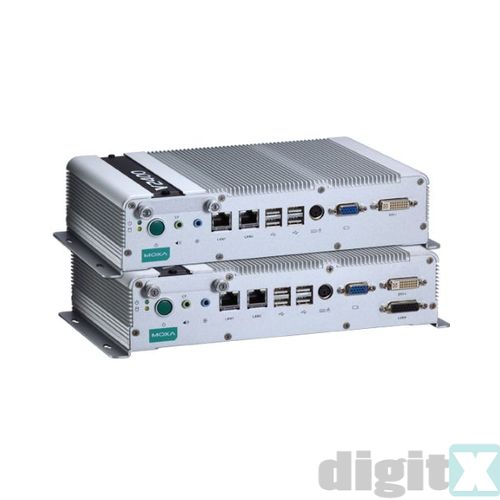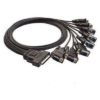
V2402-CE
x86 Ready-to-Run Embedded Computer with VGA, DVI, 2 Gigabit LANs, 4 COMs, 6 USB, 4 DI, 4 DO, Compact Flash, WinCE 6.0
Bisogno di aiuto?
Prodotti Correlati
Features and Benefits
- Moxa M2M Coloud Computing for Industrial IoT Intel Atom N270 1.6 GHz processor
- DDR2 SODIMM socket, supporting DDR2 533 up to 2 GB (max.)
- Dual independent displays (VGA, DVI, LVDS)
- 2 Gigabit Ethernet ports
- 4 RS-232/422/485 serial ports, supporting non-standard baudrates
- 8 RS-232 serial ports
- 6 USB 2.0 ports for high speed peripherals
- 4 DIs, 4 DOs
- CompactFlash socket for storage expansion
- Ready-to-run Embedded Linux, Windows CE 6.0, or Windows Embedded Standard 2009 platform
- -40 to 70°C operating temperature for harsh environment (V2402-T models only)
Introduction
The V2401/2402 Series embedded computers are based on the Intel Atom N270 x86 processor, and feature 4 RS-232/422/485 serial ports, 8 RS-232 serial ports, dual Gigabit LAN ports, 6 USB 2.0 hosts, and a CompactFlash socket. The V2401 computer provides VGA, DVI-I, and LVDS outputs, and the V2402 computer provides both VGA and DVI-I outputs, making them particularly well-suited for industrial applications such as Automatic Fare Collection. The V2401 and V2402 come with 4 RS-232/422/485 serial ports, and the V2401 has an additional 8 RS-232 ports, making them ideal for connecting a wide range of serial devices, and the dual 10/100/1000 Mbps Ethernet ports offer a reliable solution for network redundancy, promising continuous operation for data communication and management. As an added convenience, the V2401/2402 computers have 4 DIs, and 4 DOs for connecting digital input/output devices. In addition, the CompactFlash and USB sockets provide the V2401/2402 computers with the reliability needed for industrial applications that require data buffering and storage expansion. Pre-installed with Linux, Windows CE 6.0, or Windows Embedded Standard 2009, the V2401/2402 Series provides programmers with a friendly environment for developing sophisticated, bug-free application software at a low cost. In addition, the V2402 series also offers -40 to 70°C wide temperature models for harsh environments.
Computer
CPU: Intel Atom N270 1.6 GHz processor
OS (pre-installed): Linux, Windows CE 6.0 or Windows Embedded Standard 2009
System Chipset: Intel 945GSE + ICH7-M
BIOS: 8 Mbit Flash BIOS, SPI type, ACPI function supported
FSB: 400/533 MHz
System Memory: 2 GB capacity, 1 GB pre-installed: 1 x 2 GB DDR2-533 200 pin SO-DIMM SDRAM slot
USB: USB 2.0 compliant hosts x 6, type A connector, supports system boot up
Storage
Built-in: 2 GB onboard industrial DOM to store OS
Storage Expansion: CompactFlash socket for CF card expansion, supporting CF Type-I/II socket with DMA mode
HDD Support: 1 SATA-II connector for HDD expansion
Other Peripherals
KB/MS: 1 PS/2 interface supporting standard PS/2 keyboard and mouse through Y-type cable
Audio: HD audio, with line-in and line-out interface
Display
Graphics Controller: Intel Gen 2.5 Integrated Graphics Engine, 250 MHz core render clock and 200 MHz core display clock at 1.05-V core voltage
VGA Interface: DB15 female connector
LVDS Interface: Onboard HIROSE DF13-40DP-1.25 V connector (V2401 only)
DVI Interface: DVI-connector (chrontel CH7307 SDVO to DVI transmitter)
Ethernet Interface
LAN: 2 auto-sensing 10/100/1000 Mbps ports (RJ45)
Serial Interface
Serial Standards:
V2401/2402: 4 RS-232/422/485 ports*, software selectable (DB9 male connector)
V2401 only: 8 RS-232 ports (68-pin VHDC connector)
Note: *COM1’s pin 9 signal can be set by jumper as N/C (default), +5 V, or +12 V
ESD Protection: 4 kV for all signals
Serial Communication Parameters
Data Bits: 5, 6, 7, 8
Stop Bits: 1, 1.5, 2
Parity: None, Even, Odd, Space, Mark
Flow Control: RTS/CTS, XON/XOFF, ADDC® (automatic data direction control) for RS-485
Baudrate: 50 bps to 921.6 kbps (non-standard baudrates supported; see user’s manual for details)
Serial Signals
RS-232: TxD, RxD, DTR, DSR, RTS, CTS, DCD, GND
RS-422: TxD+, TxD-, RxD+, RxD-, GND
RS-485-4w: TxD+, TxD-, RxD+, RxD-, GND
RS-485-2w: Data+, Data-, GND
Digital Input
Input Channels: 4, source type
Input Voltage: 0 to 30 VDC at 25 Hz
Digital Input Levels for Dry Contacts:
Logic level 0: Close to GND
Logic level 1: Open
Digital Input Levels for Wet Contacts:
Logic level 0: +3 V max.
Logic level 1: +10 V to +30 V (Source to DI)
Isolation: 3 kV optical
Digital Output
Output Channels: 4, sink type
Output Current: Max. 200 mA per channel
On-state Voltage: 24 VDC nominal, open collector to 30 VDC
Connector Type: 10-pin screw terminal block (4 DI points, 4 DO points, DI Source, GND)
Isolation: 3 kV optical isolation
LEDs
System: Power, Storage
LAN: 100M/Link x 2, 1000M/Link x 2 (on connector)
Switches and Buttons
Power Switch: on/off (front panel)
Reset Button: For warm reboot (rear panel)
Physical Characteristics
Housing: Aluminum
Weight:
V2401: 2.1 kg
V2402: 2 kg
Dimensions:
Without ears: 250 x 57 x 152 mm (9.84 x 2.24 x 5.98 in)
With ears: 275 x 63 x 152 mm (10.83 x 2.48 x 5.98 in)
Mounting: DIN rail, wall, VESA
Environmental Limits
Operating Temperature:
Standard models: -10 to 60°C (14 to 140°F)
Wide temp. models: -40 to 70°C (-40 to 158°F)
Storage Temperature: -40 to 85°C (-40 to 185°F)
Ambient Relative Humidity: 5 to 95% (non-condensing)
Anti-vibration: 5 g rms @ IEC-68-2-34, random wave, 5-500 Hz, 1 hr/axis
Anti-shock: 50 g @ IEC-68-2-27, half sine wave, 11 ms
Power Requirements
Input Voltage: 9 to 36 VDC (3-pin terminal block for V+, V-, SG)
Power Consumption:
26 W (without LVDS output)
2.9 A @ 9 VDC
1.08 A @ 24 VDC
720 mA @ 36 VDC
Standards and Certifications
Safety: UL 508, UL 60950-1, CSA C22.2 No. 60950-1-07, EN 60950-1, CCC (GB9254, GB17625.1)
EMC: EN 55022 Class A, EN 61000-3-2 Class D, EN 61000-3-3, EN 55024, FCC Part 15 Subpart B Class A
Wheeled Vehicles: e-Mark (e4)
Green Product: RoHS, CRoHS, WEEE
Reliability
Automatic Reboot Trigger: Built-in WDT (watchdog timer) supporting 1-255 level time interval system reset, software programmable
MTBF (mean time between failures):
V2401: 238,762 hrs
V2402: 228,172 hrs
Warranty
Warranty Period: 3 years
Linux
OS: Linux 2.6.26, Debian Lenny 5.0
File System: EXT2
Internet Protocol Suite: TCP, UDP, IPv4, SNMPv1/v2c/v3, ICMP, ARP, HTTP, CHAP, PAP, SSH 1.0/2.0, SSL, DHCP, NTP, NFS, Telnet, FTP, TFTP, PPP, PPPoE
Internet Security: OpenVPN, iptables firewall
Web Server (Apache): Allows you to create and manage web sites; supports PHP and XML
Terminal Server (SSH): Provides secure encrypted communications between two un-trusted hosts over an insecure network
Dial-up Networking: PPP Daemon for Linux that allows Unix machines to connect to the Internet through dialup lines, using the PPP protocol, as a PPP server or client. Works with ‘chat’, ‘dip’, and ‘diald’, among (many) others. Supports IP, TCP, UDP, and (for Linux) IPX (Novell).
File Server: Enables remote clients to access files and other resources over the network
Watchdog: Features a hardware function to trigger system reset in a user specified time interval (Moxa API provided)
Application Development Software:
Moxa API Library (Watchdog timer, Moxa serial I/O control, Moxa DI/DO API)
GNU C/C++ compiler
GNU C library
Perl
Windows XP Embedded
OS: Windows Embedded Standard 2009 SP3
File System: NTFS
Internet Protocol Suite: DHCP, DNS, FTP, HTTP, SNTP, NTP, Telnet, SMTP, SNMPv2, TCP, UDP, IPv4, ICMP, IGMP, IPsec, TAPI, ICS, PPP, CHAP, EAP, PPPoE, PPTP, NetBIOS
Web Server (IIS): Allows users to create and manage websites
Silverlight 2.0: A free runtime that powers rich application experiences and delivers high quality, interactive video across multiple platforms and browsers, using the .NET framework
Remote Registry Service: Enables remote users to modify registry settings on this computer
Remote Desktop: The Terminal Server Remote Desktop component provides remote access for the desktop of a computer running Terminal Services
Watchdog: Features a hardware function to trigger system reset in a user specified time interval (Moxa API provided)
Enhanced Writer Filter: Redirect disk write operations to volatile (RAM) or non-volatile (disk) storage
File Based Write Filter: The File Based Write Filter (FBWF) component redirects all write requests directed at protected volumes to the overlay cache, which records and displays the changes while preserving the protected status of the target volume.
Application Development Software:
Moxa API Library
Microsoft .Net Framework 3.5 with SP1
Active Directory Service Interface (ADSI) Core
Active Template Library (ATL), ASP.NET 2.0
Common Control Libraries
Common File Dialogs
Direct3D, DirectPlay, DirectShow, and Direct show filters
Mapi32 Libraries
Message Queuing (MSMQ) Core
Microsoft Visual C++ Run Time Libraries
Power Management dynamic-link library
RPC
Windows API, Script Engines, and WMI
Windows Embedded CE 6.0
OS: Windows Embedded CE 6.0 R3
File System: FAT (for on-board flash)
Internet Protocol Suite: TCP, UDP, IPv4, SNMPv2, ICMP, IGMP, ARP, HTTP, CHAP, PAP, SSL, DHCP, SNTP, SMTP, Telnet, FTP, PPP
Web Server (WinCE IIS): Supports ASP, ISAPI Secure Socket Layer (SSL 2/3) and Transport Layer Security (TLS/SSL 3.1) public key-based protocols, and Web Administration ISAPI Extensions
Dial-up Networking: Supports RAS client API and PPP, Extensible Authentication Protocol (EAP), and RAS scripting
File Server: Enables remote clients to access files and other resources over the network
Watchdog: Features a hardware function to trigger system reset in a user specified time interval. (Moxa API provided)
Application Development Software:
Moxa WinCE 6.0 SDK
Moxa API Library
C Libraries and Run-times
Component Services (COM and DCOM)
Microsoft® .NET Compact Framework 2.0
XML, including DOM, XQL, XPATH, XSLT, SAX, SAX2
SOAP Toolkit Client
Winsock 2.2


